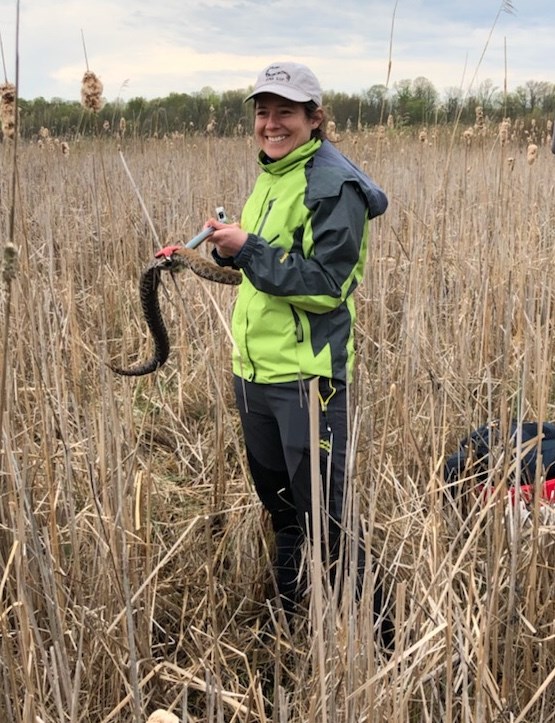Often, when I welcome entrepreneur groups to the Edward Lowe Foundation, I tell them about our conservation work. I point to our restored prairies, woodland management practices and habitat enhancement projects that support the many wildlife species at Big Rock Valley. Everyone is usually quite interested — until I get to the part about snakes, particularly our work with massasauga rattlesnakes. Suddenly their interested smiles fade, replaced by looks of concern, and I’ve even seen some cringe.
“You’re kidding, right?” they ask. “No? So, where shouldn’t we walk?”
Yet rather than be feared, snakes should be revered, for they’re an important part of biodiversity — a message that hit home with me earlier this year when I visited with members of the Eastern Massasauga Rattlesnake Species Survival Plan.
The EMR SSP is a consortium of more than 20 North American zoos dedicated to enhancing the captive population of massasaugas and promoting its conservation in the wild. The foundation has had a partnership with the SSP since 2009, and each May the group travels to Big Rock Valley to hold its annual planning meeting where they discuss breeding practices for snakes in their respective zoos. Members also spend considerable time combing through the wetlands and grasslands of our property searching for massasaugas. Both environmental and genetic data is collected, which is used for a longitudinal study that will help establish best practices for conserving the snakes. It’s a pretty significant project because few long-term datasets exist for the eastern massasauga, a species now listed as a federally threatened.

Education is also an important component of the group’s work — and not an easy one, says Billie Harrison, who chairs the EMR SSP’s outreach committee. “Most people don’t encounter a snake very often and when they do, it tends to be a surprise — for both parties,” says Billie, pointing out that most snakes, and especially the massasauga, are quite shy animals.
Passionate about correcting the bad impression people often have of snakes, Billie points to a number of reasons why humans should think more kindly of these creatures:
- Life-saving drugs. Research with venomous animals have led to many life-saving drugs. Indeed, the development of ACE inhibitors in the 1980s, one of the great breakthroughs in cardiovascular medicine, was based on a South American pit viper. Another example, the anticoagulant drug Integrilinis is derived from the southeastern pygmy rattlesnakes (a close relative of the eastern massasauga rattlesnake) and can be an alternative to angioplasty or bypass surgery.
- Taking out rodents. Since many snakes, including the massasauga, consider mice and voles to be a great delicacy, they help control rodent populations. Thus, snakes are a friend to farmers because they prevent rodents from damaging crops both in the field and in storage. Snakes also help control a number of rodent-related diseases, including Lyme disease. Indeed, University of Maryland researchers who studied timber rattlesnakes, which is endangered or threatened in many states, estimated that a single timber rattlesnake consumes up to 4,500 ticks a year by swallowing infected mice.
- Family-oriented homebodies. Studies have shown that rattlesnakes, including massasaugas, have “kin attendance” — meaning that not only are massasauga mothers good parents, but related animals will babysit young litters and help protect them from potential predators. Anecdotally, the snakes get to know their surroundings and show a preference for a certain home.
And then there are their environmental contributions. Because they serve as both predator and prey, massasauga rattlesnakes are a critical part of a healthy wetland ecology, which is their favorite habitat. And wetlands, in turn, are critical to humans. Wetlands control floods and alleviate drought conditions. They reduce erosion and sequester carbon. They also improve water quality by absorbing excess sediment from agricultural, septic and storm water runoff before it enters groundwater or nearby streams.
It’s important to understand how every creature is related to its environment, points out John Adamski, assistant curator at Seneca Park Zoo in Rochester, New York, who works with Billie on the EMR SSP’s outreach committee. “Everything has its place, however, it’s easy for humans to discount that because we look at ourselves as the master,” he said. “Yet we can’t take ourselves out of the environment. And keeping that environment intact as many ways as possible will have benefits for everyone including us.”
As a result of talking with Billie and John, I’ve started to change my messaging. Instead of just briefly mentioning our work with massasaugas, I’m going to dive in deeper and discuss the positive role snakes play in our environment. These reptiles deserve our respect. Cringing is not an option.
Published 7/25/2017
